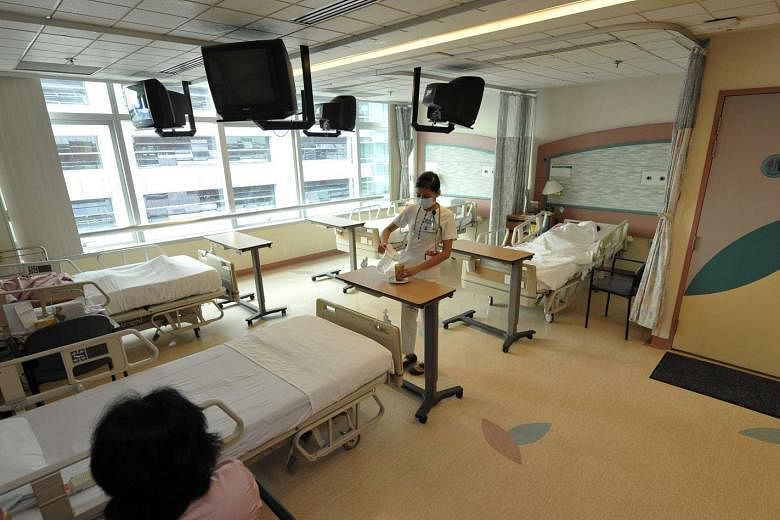The Ministry of Health's move last week to introduce a standard B1 health insurance plan got me elated for about 30 minutes.
I read the news flash from my colleagues, about the new standard B1 health insurance plan offered by five private health insurers that offers a tier of coverage above MediShield Life, at affordable premiums.
Fantastic, I thought. Maybe I can finally buy private health insurance. I am covered only under basic MediShield Life.
But my elation was short-lived.
Those who bought higher class coverage they didn't need can now downgrade to this plan with no penalty.
The new plan doesn't allow people to automatically upgrade from basic to standard B1 coverage if they are prepared to pay the premiums.
Instead, private insurers can still cherry pick who they want to cover from this group, and what the terms are. This means they can still reject the middle-aged with past or current medical conditions (like me - I had cancer over 10 years ago) and take on only the young and healthy.
As MOH said in its press release: "Insurers are allowed to assess, approve with or without exclusions, or reject applications based on their own risk assessment frameworks."
It did add, helpfully: "Regardless of the underwriting outcome, all Singaporeans are covered for all pre-existing conditions under MediShield Life."
To be fair to the MOH, it was only three years ago that it took the big step of extending health insurance to all, covering even those with pre-existing illness. It has been working hard since to work out the implementation details.
It has also done a creditable job getting the five insurers on board to agree to a standard menu of B1 coverage at relatively affordable premiums - thus keeping faith with what the Medishield review panel had recommended.
But I am disappointed that the ministry, while reviewing B1 private health insurance coverage, did not take the opportunity to regulate private health insurers more tightly.
As my colleague, veteran health correspondent Salma Khalik, pointed out, the new plan doesn't address many concerns.
One salient observation she made was that adding one more standard B1 plan to the plethora of existing B1 plans offered by private insurers risks splitting the risk pool. A smaller risk pool might also end up driving premiums.
"Currently, fewer than 500,000 people, or just 19 per cent who have IPs, have opted for B1 coverage. By adding more B1 plans, is the ministry simply splitting the risk pool further? Will this result in greater premium fluctuation?"
Private health insurance in a country is only as good as the regulator forces it to be.
If you allow pure market forces to prevail, you will have profit-maximising insurers springing up, offering to cover the young and healthy who aren't likely to make claims, and ditching them as they get older or when they get sick.
Hence, regulators often insist that medical coverage be "guaranteed renewable" - which means the insurer must guarantee that you can renew your policy every year, and can't cancel on you the year after you get sick and make a claim.
Has Singapore ensured that its regulation of private health insurance provides a good outcome for patients?
A look at how other jurisdictions like Australia regulate health insurers is instructive.
In Australia, a tax-funded health care system called Medicare provides universal health coverage for all. In addition, Australians are encouraged to buy private insurance to top up their coverage, with the government giving a rebate on premiums by up to 30 per cent, depending on income.
Younger people are encouraged to sign up early before they turn 30. Otherwise, they pay an extra 2 per cent loading on top of the premium for each year they are above 30. (If you delay private insurance and choose to take it up at age 40, that's a whopping 20 per cent more in premiums. But at least the insurer will still cover you, regardless of whether you have pre-existing illness, unlike in Singapore). Getting people on board private insurance, and from a young age, ensures a large and sustainable pool of members for the insurer to cover.
Four regulations in particular ensure that patients are not worse off and left uninsurable or slapped with too-high premiums as they get older and sicker.
You can read the Australia report here.
No individual rating
The first rule is that insurers are not allowed to do individual rating - which means they can't discriminate against an individual just because he or she is sick or likely to get sick. Instead, insurance plans are community rated - the whole group is assessed together, and premiums set accordingly.
This concept is startlingly new to many Singaporeans, but is one of the bulwarks of health insurance. The very idea of insurance after all is to pool risks, not let private insurers cherry pick to the detriment of those who most need medical coverage.
Risk equalisation fund
To prevent insurers from setting premiums deliberately high to keep out the old and sick, and to make sure insurers who do take on on older, sicker patients are not disadvantaged, the regulator ensures there is something called a risk equalisation fund.
This essentially means the regulator steps in and looks at all the insured patients across all the private insurers, and then reallocates risks and funding so insurance companies with sicker members don't lose out, and an insurer does not have an incentive to pick only young, healthy members to insure.
The premiums set by the five insurers offering the new standard B1 plan vary so widely - it makes one wonder if some of the insurers price their premiums so high for the very old, to discourage them from coming on board, and prefer to shunt them off to other insurers.
A risk equalisation fund removes such incentives.
Portability
Third, as for telcos here, there are rules for portability across health insurers. You can take up one insurer's policy this year, and switch to another without penalty.
If the new insurer offers higher benefits not covered in your old policy, you may need to wait 12 or 24 months before claiming for those new provisions. But the new insurer can't reject you.
Ministerial approval
Fourth, premium changes and requirements set by private health insurers need ministerial approval.
To my mind, these are clearly sensible, superior ways of regulating private health insurance to ensure an outcome that is good for all patients. Yet there has been no such move to regulate private health insurers here.
It is commendable that MOH chose to step up to get private insurers to agree to a standard B1 plan at affordable premiums.
But that is setting the bar rather low. The review has become a missed opportunity.
Instead of a thorough review of regulation to bring private health insurers here to heel in a way that truly benefits patients, MOH has chosen to allow private health insurers here to continue to cherry pick patients.


